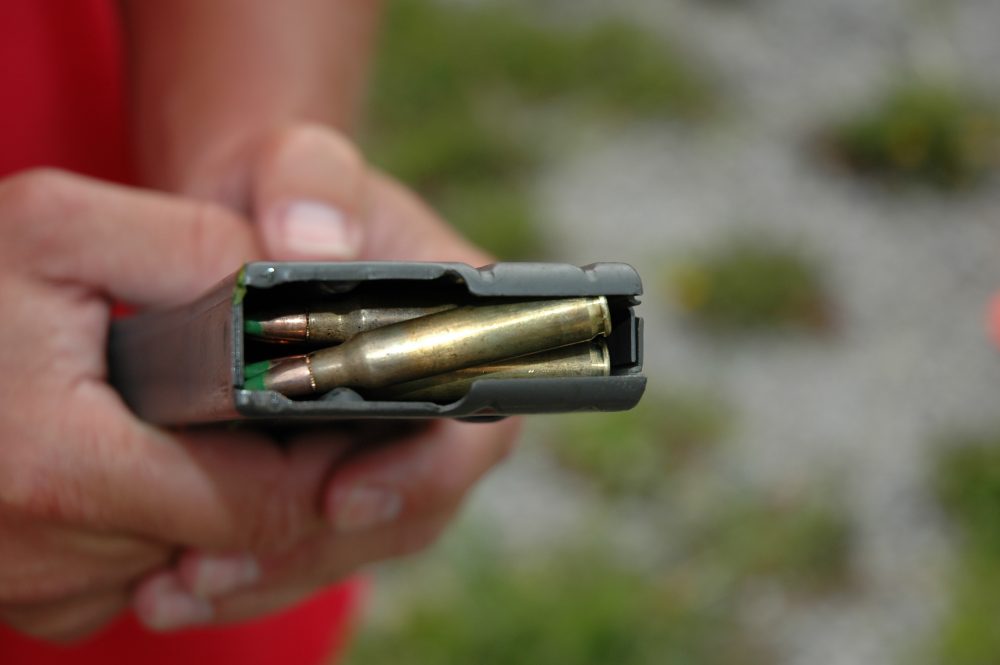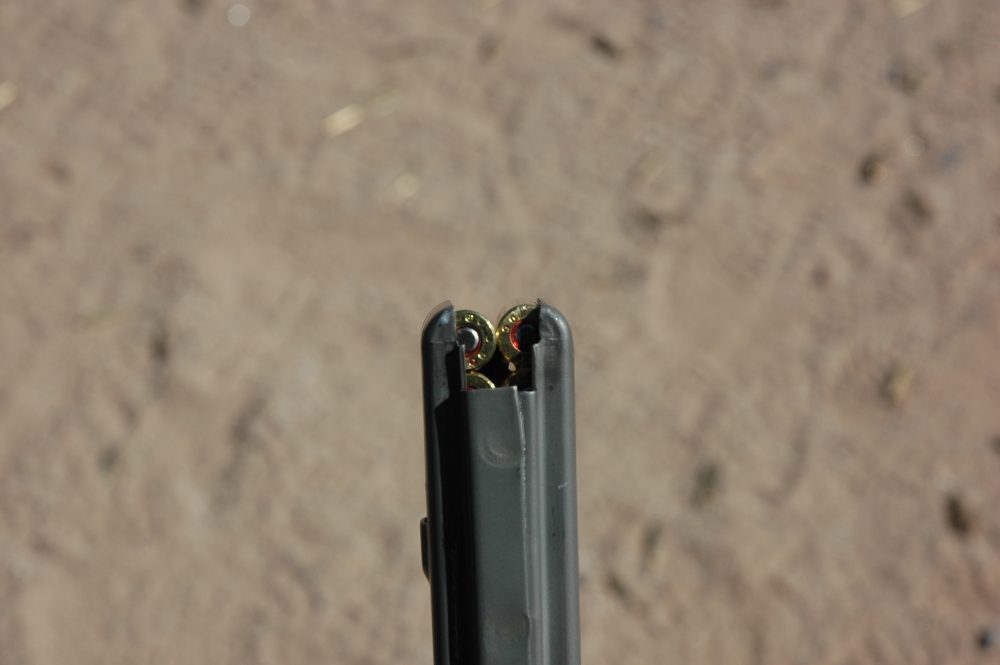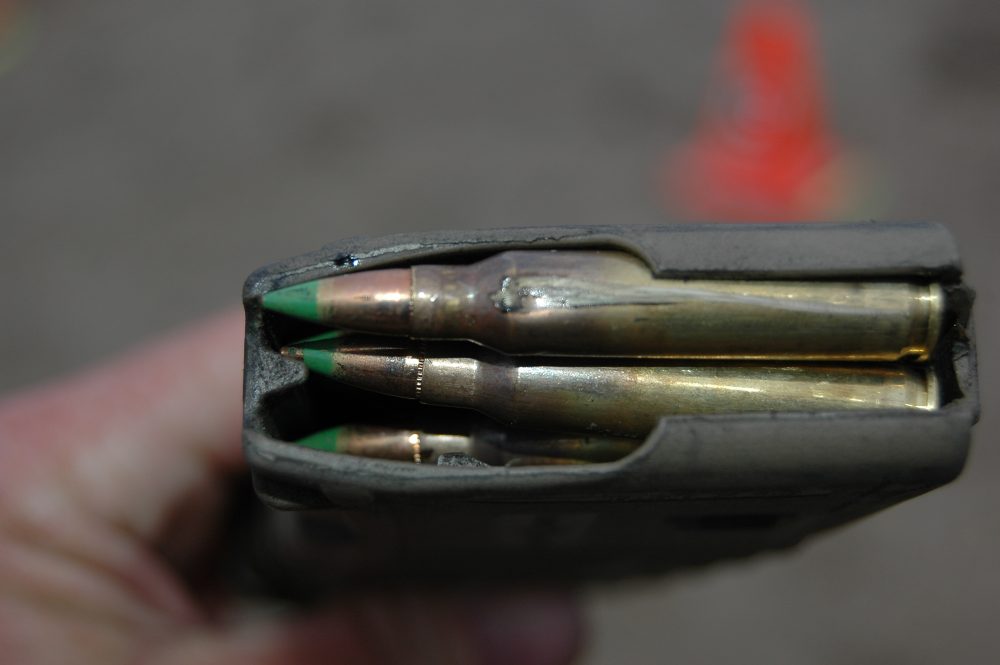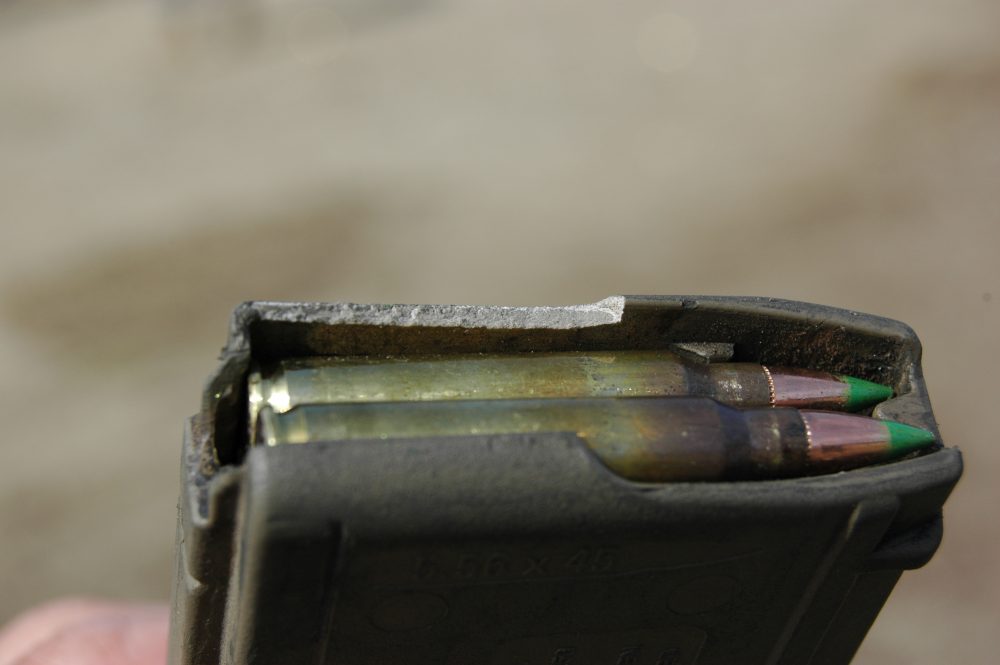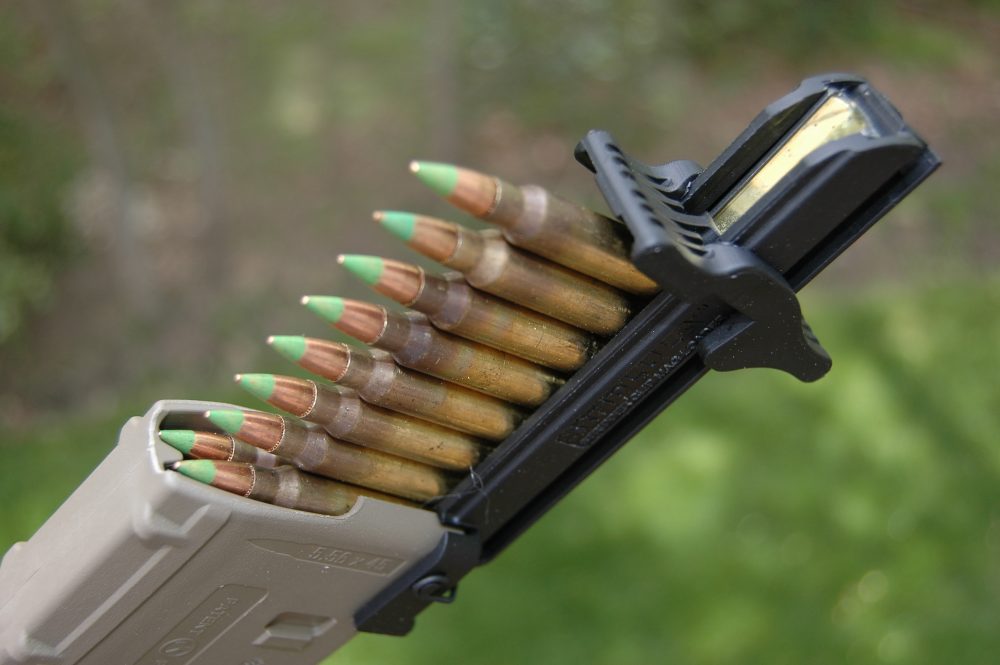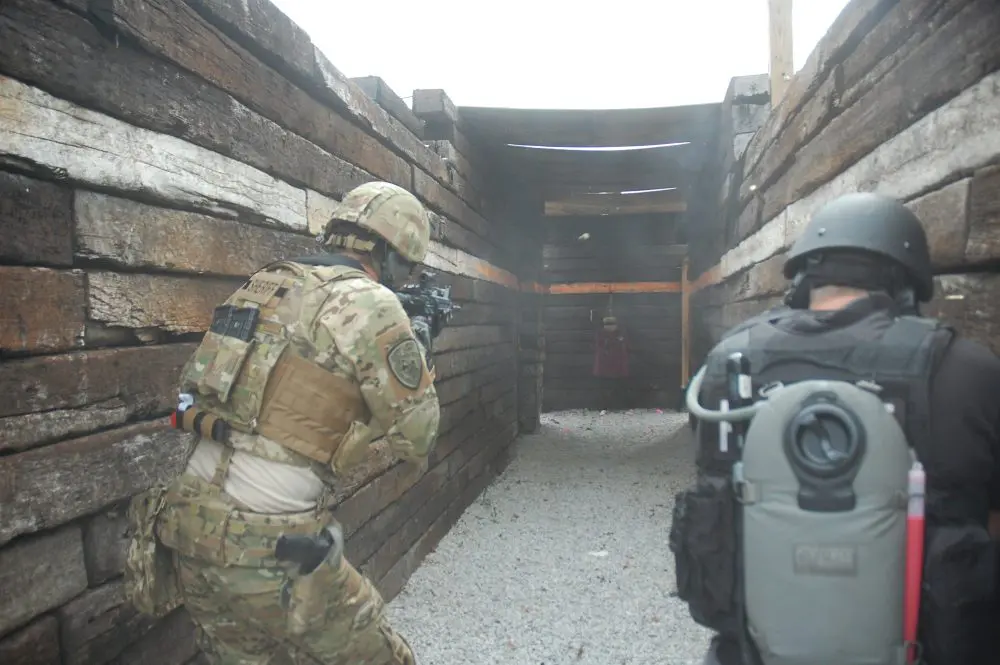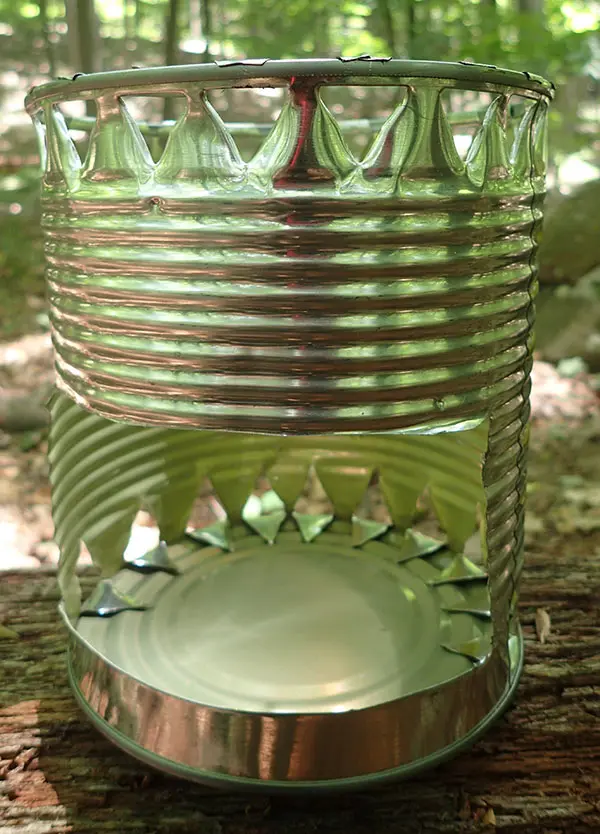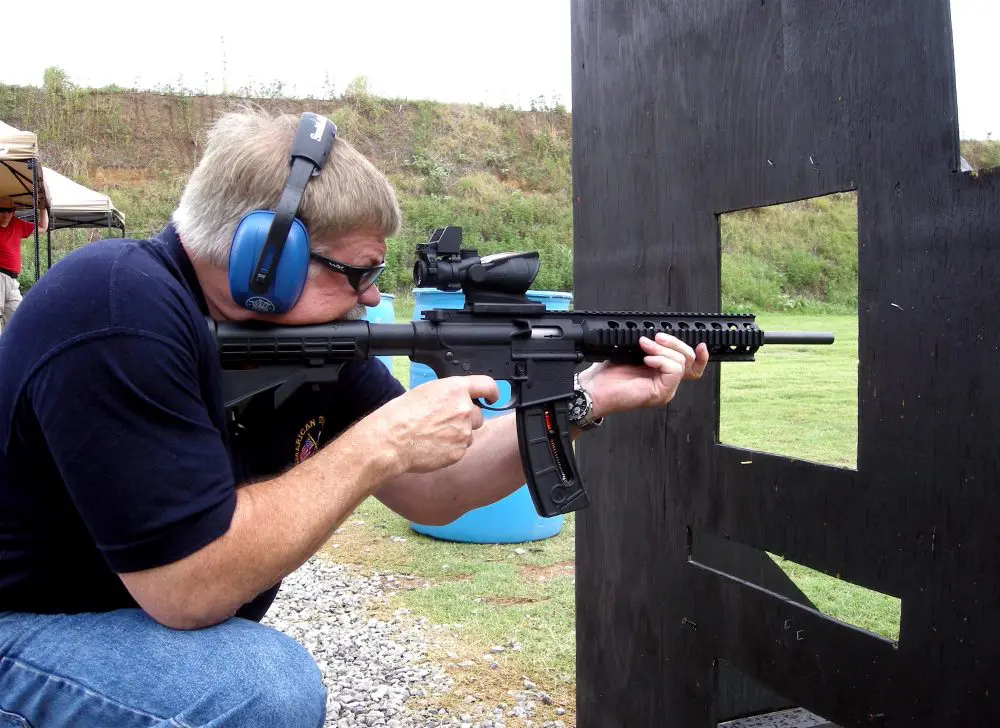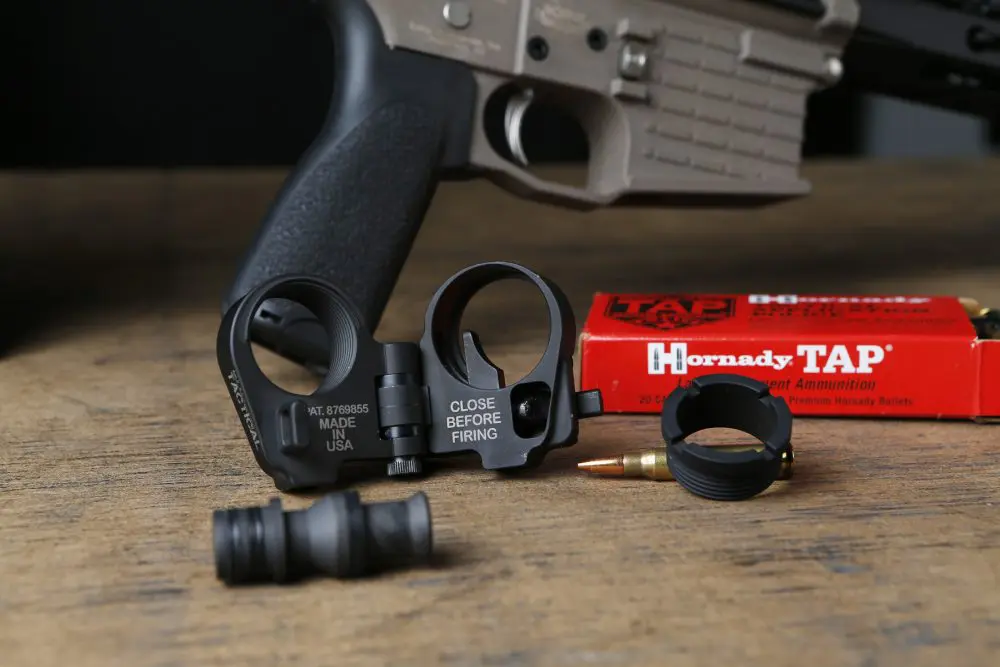As the years go rapidly by, I sometimes reflect on why people do the things they do. I don’t mean things like breathing, eating and procreating, but chores like loading magazines. Specifically M4-type magazines.
Right now, commonly used M4 magazines are made of aluminum (issue magazines and their clones), steel (the HK mags) or polymer (specifically the PMAG, it being the most common).
Ammunition may come in cardboard boxes in either the 20- or 50-round denomination, or on ten-round clips.
Loading loose rounds is time consuming, but positive. Several companies have plastic loaders to assist in easing the drudgery, and depending on your outlook, they can be anywhere from OK to a waste of money.
Mag-loading issues are nothing new. This photo, shot eight years ago, shows misalignment of cartridges that occurs when slamming rounds into the magazine.
On the mil side of the house, all 5.56x45mm service ammunition comes linked or on clips (with few exceptions). In order to bridge the gap between those ten rounds looking so proud on that clip and ten rounds dealing death as they are fired from a magazine, a magazine filler (called a spoon on the errornet) is used.
The filler is placed on top of the magazine. The clip is placed into the filler until it stops. Joe then presses his thumb on the top cartridges and exerts smooth pressure downward, causing all ten rounds to enter the magazine. Repeat this two times (less two rounds) and you have a loaded magazine.
Pretty slick, except it doesn’t always work that way.
Sometimes friction overcomes slow, steady pressure, which is replaced by brute force. About halfway through a loadout, I’ll manage to inflict one or more lacerations on my paws, which will become infected, and lead me to (naturally) use more force to get those little things in their next-to-final home.
A simple way of using additional force to jam those mags is to place the cartridges against a handy table, bench or whatever. Put the base of the magazine against your body and push that bad boy down at warp speed. Yeah, that’s the way.
No more sliced skinners for me. Sure…
There are, of course, variations on that theme, and all involve slammin’ those rounds into the magazine.
Damage to magazines can come from many sources. Feed lips from this magazine are spread, and two top rounds are almost at the same level. No good can come from this.
But this is all for the greater good, right? Less time spent jammin’ mags means more time for other things (feel free to list those other things here).
Well, maybe not.
When you load that magazine as it is supposed to be done—pressing straight down on the top cartridge until it enters the magazine—each round is staggered in as it is supposed to be.
When you slam the rounds in, occasionally the rounds may become misaligned—that is, one round may wind up seated diagonally across the magazine. This may prevent other rounds from seating (commonly) or one or more rounds may feed normally, hiding the problem.
We have seen this occur with all of the magazines in common use—issue aluminum, HK and PMAG.
Additionally, we have seen this occur when loading loose rounds with the C-Mag Personal Loader.
This is easily prevented by simply not putting your superhuman-powers cape on prior to loading magazines.
Let’s take it a step forward. When you take an empty magazine, place the base on a table, properly fit the filler to the mag and insert the clip—you are cooking. Pressing firmly down on the top cartridge will cause all of the rounds to enter the magazine properly. Nothing touches the magazine feed lips—there is no gross insult to the feed lips. And those feed lips are crucial to the feeding of the round into the chamber.
This PMAG exhibits the same misalignment as issue aluminum mags do when they are slam loaded.
All is well.
But when you place that cartridge against a hard surface and use the full weight of your body to slam the magazine onto those rounds, the feed lips will contact that surface. And while one or two contacts may not be enough to cause any problems, one or two times may be all that is needed to cause enough damage to make the feed lips stop working as advertised.
The issue aluminum magazines may (according to some knowledgeable folks) have a bit of flexibility that will permit the lips to move back to their original position. However, over time the constant flexing will mean that it is less likely to return to its original shape. The flexing will eventually cause fatigue, which will cause cracking and therefore complete failure. Once that process starts, the inevitable result will be failure.
The most obvious form of failure will be that the feed lips will spread. Unfortunately, this is not something that you will be able to ascertain with visual inspection, and it may only become apparent when, during the feeding cycle, a round will pop up as the bolt cycles, causing a Type 3 Malfunction (a double feed).
Or it may manifest itself during an open bolt reload. When the magazine is inserted into the mag well forcefully, the weakened lips will further spread, causing one or more rounds to pop up into the upper receiver. When many rounds flood the upper receiver, it is commonly called a volcano.
Repeated impacts to feed lips will cause damage. In an aluminum magazine it may not be visible, and you will know it only when it fails while firing. Polymer magazines will exhibit a visible cracking. The key here is to not abuse magazines while loading.
This is not uncommon. Last week, at a military class, we saw this four times. In each case they were older magazines (with black followers).
As the lips spread, cracks may appear along the feed lips or across the back of the magazine at the “U” notch. These should be visually apparent.
The steel magazines have little flexibility, and while they are possibly more resistant to initial damage, they are less likely to take repeated insults without lasting damage. The steel feed lips will bend and stay bent. The result will be the same as with issue aluminum magazines.
We had some terrific problems with some of these magazines in 2003. There was a lot of finger pointing by one employee who was eventually fired, but the bottom line is that you can expect lips to spread, bodies to dent and failure to occur with use.
PMAGs are polymer and therefore probably more resistant to damage. Because of the nature of the material, the lips will return to spec after being bent. However, this bending cannot last forever, and repetitive whacks will eventually cause the lips to crack. The good news is that it is immediately apparent and impossible to ignore. There is no danger of the magazine being given a cursory once-over by the armorer and tossed back into the bin of soon-to-be-issued magazines.
Strip Lula alleviates the slammin’ issues. Author’s limited experience indicates it may be a viable option.
PMAGs apparently stand up to some abuse that would cause metal magazines to fail. However, the material used for the magazine—polymer—causes some to automatically remove them from the line up. After all, who wants a magazine (rifle, flashlight, etc.) made of plastic? Everyone “knows” that plastic yadayadayada. These people are the same ones who eschew tactical slings, optical sights and computers.
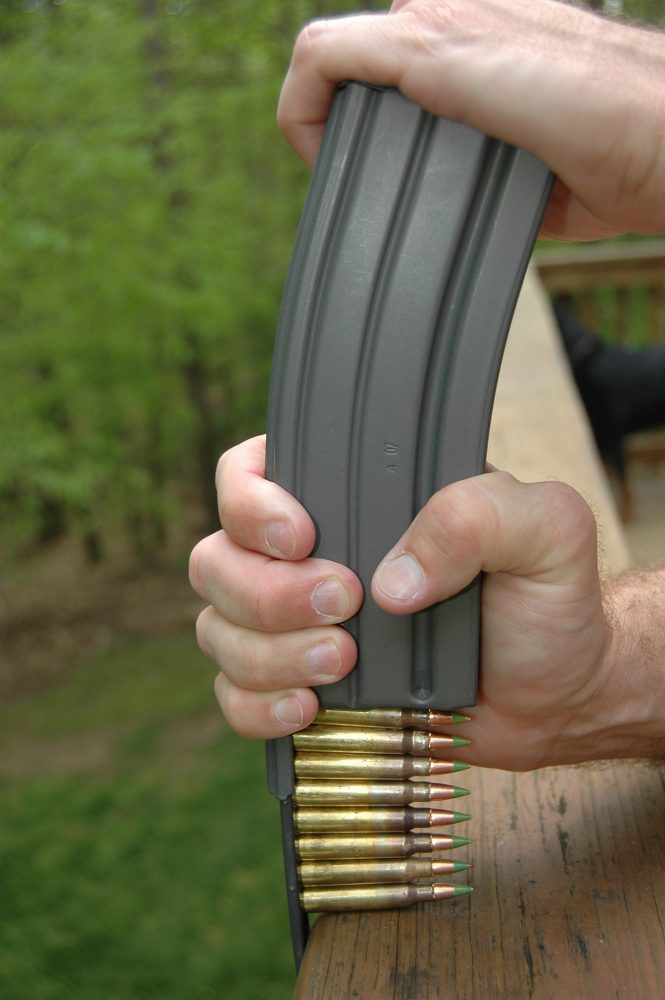
I’ll make a prediction here. Pretty soon all M16-type magazines will be made from polymer. Metal magazines are soon to be on their twilight cruise.
So how do we avoid problems? The simple answer is to use the issue clip and filler as they should be used. Use the C-mag Speed Loader and the Personal Loader—manufactured by The Beta Company—without forcing them. I am not normally a fan of the Lula Loader, but the Lula Stripper is reported to rapidly load the ten-round clip without having to resort to force.
We aren’t stating that the sky is falling, and this is not something newly discovered. Clearly people have been loading M16 magazines with clips for well over 40 years with reasonable success. People have been aware of this since the early 1970s, but it seems like we have to relearn these things every few years.
Perhaps the issue is that people who didn’t have a clue as to the potential issues down the line have put a lot of damaged magazines back into service.
No magazine is perfect. Neither is anything made by man, or man himself. When errornet pundits pronounce something as being flawless, they are just announcing to the world that they have absolutely no clue what they are talking about. A more visual way of explaining this is that they will show their bare hindquarters to the assembled multitudes.
Is improper loading the only way to damage magazines? Nope. Understand that dropping magazines on the deck—especially a hard surface—can cause the magazine to disassemble itself or damage the body. HK has a multi-page manual for their magazine and specifically warns against this.
The reality of tactical life is this: we drop magazines during training as well as operationally, and they will fall wherever we may be standing.
Magazines are wear items. They are not made to last forever, and advertising to the contrary is just more used car sales tactics being applied to the gun industry.
In short, anything that you do to your magazine (likewise your gun, camera, car, aircraft, et al) will cause wear, and that wear will eventually lead to failure. If you don’t want your magazines to wear out, don’t use them.
Magazines are currently plentiful, in many shapes, forms, materials and colors. Prices are reasonable, but you can assume that those prices will rise and availability will fall as the winds of political change sweep toward the left.
Having more magazines is always better than having fewer magazines, but having good magazines to start off with makes the process easier.
Understand that when a magazine starts to exhibit problems, you must be able to identify the problems and watch them carefully. Numbering magazines aids in this process. When that same magazine is problematic twice, take it out of the rotation. If it is a question of failing springs, you can replace the spring (and follower), but if it has feed lip or body problems, give it some hammer therapy.
Magazines are the feed devices that change a weapon from an inefficient firearm to something significantly different. Acquire these feed devices wisely. Replace them as necessary.
And finally, do not fall in love with your magazines. That will bite you in the butt and cause mission failure down the line.
[Pat Rogers is a retired Chief Warrant Officer of Marines and a retired NYPD Sergeant. Pat is the owner of E.A.G. Inc., which provides services to various governmental organizations. He can be reached at [email protected]]
SOURCES:
The Beta Company
Dept. S.W.A.T.
2137B Flintstone Drive
Tucker, GA 30084
(800) 669-2382
www.betaco.com
Bravo Company USA, Inc.
Dept. S.W.A.T.
P.O. Box 341
Hartland, WI 53029
(877) 272-8626
www.bravocompanyusa.com
Magpul Industries Corp.
Dept. S.W.A.T.
400 Young Court
Erie, CO 80516-8440
(877) 462-4785
www.magpul.com
